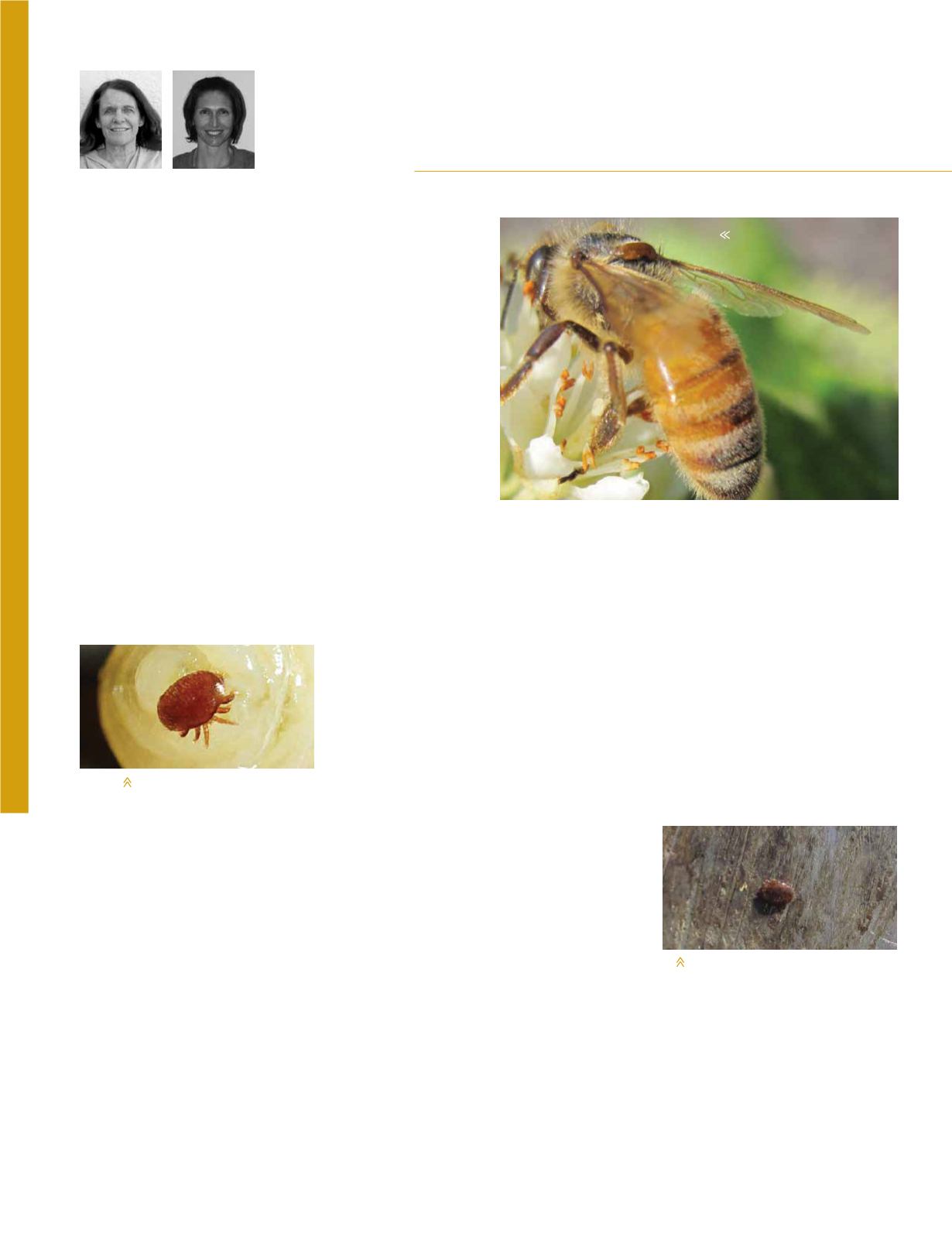
38
Almond Facts
MARCH | APRIL 2015
THE BEE BOX
The Bee Box
CHRISTI HEINTZ
& TARA MCCALL
Project Apis m.’s main objective is to facilitate beekeepers’
ability to provide a sustainable and healthy supply of honey
bees for almond pollination. To that end, Project Apis
m. (PAm) has infused over $3 million into research and
programs focusing on pests, diseases, nutrition, pesticides
and long-term stock improvement. PAm has also developed
Best Management Practices (BMPs) and programs to build
forage partnerships with other companies, organizations
and non-profits. Yet, we keep coming back to the No. 1
problem that has been around and causing problems with
honey bees for too long — and that is a pesky little mite.
“While many factors contribute to honey bee declines,
there is consensus that the single most important
contributing factor is Varroa mites,” said Dr. Dennis
vanEngelsdorp, University of Maryland entomologist.
The Varroa destructor is a blood sucking parasitic mite
that feeds on adult and pupal bees. Though first reported
in 1904 in Indonesia, it wasn’t discovered in the United
States until 1987 in a migratory beekeeper’s colonies in
Wisconsin. Since then, Varroa has been documented in all
50 states in the U.S. and is recognized as the biggest pest to
honeybees worldwide, most likely the largest contributing
factor in the recent decline of honeybees, causing the
devastating effects of colony collapse.
Varroa mites attack
honey bee colonies
by attaching
themselves to the
adults and larvae,
transmitting diseases,
affecting the immune
response of honey
bees and reducing
their lifespan. Mites
are about the size
of a pin head, and levels are routinely monitored by
beekeepers. At a threshold of three mites per one hundred
bees, beekeepers need to treat the colony with a miticide
— and there are too few legal options available for the
seriousness of the pest. As mite populations explode, often
in late summer, colonies will begin to suffer. “If you have
greater than six mites per hundred bees, your colonies are
dead; they just don’t know it yet,” said Dr. vanEngelsdorp.
In September 2017, the Varroa will have been in the U.S.
for 30 years – that’s 30 years too long for this vital link
in the pollination of over 90 different crops! PAm and
our partners are committed to NOT having a 30-year
anniversary party for the Varroa mite. PAm currently
supports several research efforts to detect and control the
Varroa mite.
Bee breeding efforts to develop resistance against Varroa is
being conducted at universities in Washington, Minnesota
and North Carolina and with the USDA in Baton Rouge,
Louisiana. A partnership with
Blue Diamond Growers
has
secured funding for in-field diagnostic testing of bee viruses
with Dr. Michele Flenniken, Montana State University,
and for colony strength evaluations with Robert Seccomb
and Dr. Jerry Bromenshenk of Bee Alert, Inc. Recently,
CoBank and American Ag Credit matched
Blue Diamond
Growers’
donation and that funding will specifically target
the Varroa mite. In addition, PAm has asked bee brokers
to match the $100,000 contribution because we expect to
receive several innovative proposals, including several from
disciplines outside the normal bee scientist community.
There will be NO anniversary celebration for the Varroa!
A sneak preview of just a few of the latest novel approaches
for Varroa control involve an appreciation for biochemical,
environmental and even some electrical approaches that
decrease or eliminate the chemical Varroa controls
currently used.
PAm has funded
Dr. James Ellis,
University of Florida,
in using RNA
interference, or RNAi
for Varroa control.
Using RNAi involves
biochemically altering
the susceptibility of
the mites to miticides, allowing the miticides to work
again, possibly at even lesser concentrations. Now that
both the Varroa and the honey bee genomes have been
sequenced, RNAi technology may provide one useful tool
for Varroa control.
Washington State beekeeper Eric Olson lost 56 percent
of his colonies or 9,000 colonies in the winter of 2010
- 2011. His bees, and his almond pollination contracts,
Varroa mite on honey
bee pupae (Photo by
Kathy Keatley Garvey)
Varroa mite scraped onto a hive
tool (photo by Christi Heintz)
Varroa tmite piggy-backing
on the a foraging honey bee
(photo by Christi Heintz)


